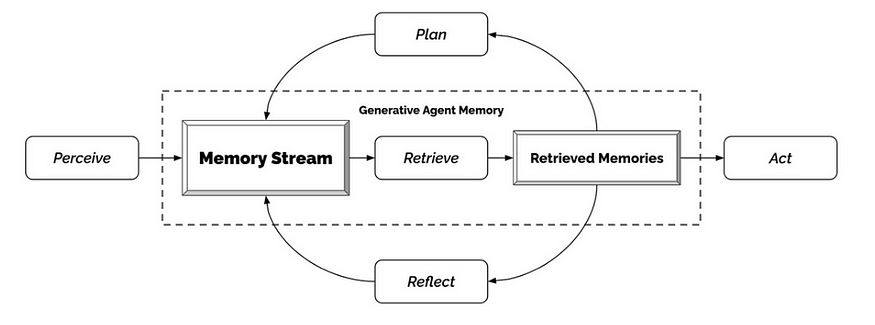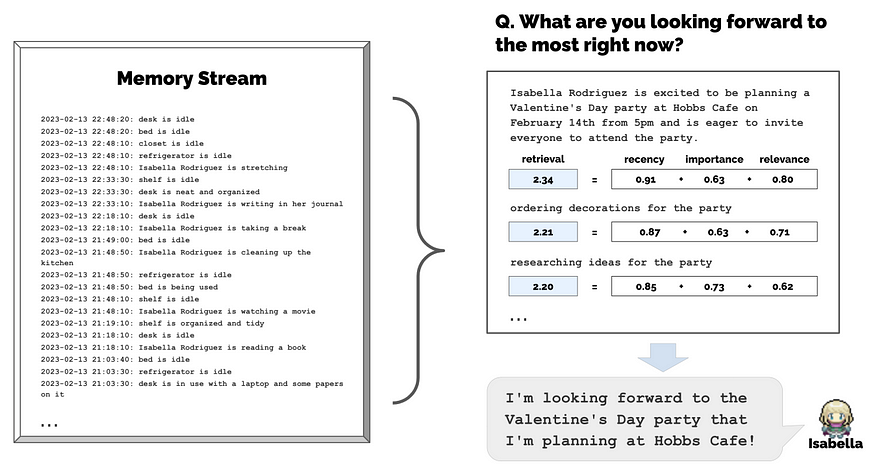Explore Generative AI Agents that can Remember, Reflect, and Plan Actions
Last Updated on June 15, 2023 by Editorial Team
Author(s): Sriram Parthasarathy
Originally published on Towards AI.
Discover How Generative Agents can Redefine Training, Entertainment, and Communication Across Sectors.
Generative agents, innovative computer programs that imitate human behavior, have the remarkable ability to remember, reflect, and plan actions. These agents can create lifelike virtual worlds that closely resemble real-world situations, offering valuable applications in training, entertainment, and communication.
Stanford researchers (https://arxiv.org/pdf/2304.03442.pdf) have developed a simulated town using generative artificial intelligence (AI) that comprises characters with unique identities, memories, and behaviors, similar to the concept of the HBO series “Westworld.” The simulation includes 25 “generative agents,” each with their own identity(name, occupation, priorities), relationships, and plans for each day. The characters can remember past information, develop new thoughts, and plan future actions. They can also form relationships, remember past details, and be capable of coordinating with each other.
The research shows that memory and retrieval are crucial for the simulated characters. They can review their memories to gain new insights and change their plans based on new observations and thoughts. For example, in the simulation, one of the characters, Sam meets Latoya, a character who shares that she is working on a photography project. When Sam and Latoya meet again, Sam inquires about the progress she has made on her project.
Just like how humans can think about the recent past, learn and reflect on it and take specific actions moving forward, the characters in the simulation have the ability to review their memories and gain new insights. They can also reflect on previous reflections and adjust their plans based on new observations and thoughts.
Agent Architecture
Agents are expected to act and react in ways that are consistent with human behavior while also being capable of planning and reflecting on past experiences. To achieve this, a new architecture that combines memory and retrieval, reflection, planning, and reacting has been proposed.

The proposed architecture is designed to mimic the way in which humans process information and make decisions. The architecture includes four components: memory and retrieval, reflection, planning, and reacting. Each component plays an essential role in allowing the generative agents to behave in a more human-like manner.
1. Memory and retrieval
The first component, memory, and retrieval, is responsible for storing and retrieving information about the agent’s experiences and environment. The agent’s memory is a stream of events that are continuously added to the memory as the agent interacts with its environment. The retrieval process is responsible for selecting the most relevant events from the memory stream based on the current context. When retrieving memories, three factors are crucial: recency, importance, and relevance. Recent memories hold more significance, memories perceived as important by the agent are prioritized, and memories relevant to the situation or query are considered vital for retrieval.

2. Reflection
The second component, reflection, is responsible for generating higher-level, abstract thoughts that are based on the agent’s observations and experiences. These thoughts are called reflections and are generated periodically based on a threshold of importance scores for the latest events perceived by the agents. Reflections allow the agent to generalize and make inferences based on its observations, enabling it to respond appropriately to complex stimuli.
3. Planning and Reacting
The Planning and Reacting component of the agent consists of two key processes. Planning, involves the creation of future sequences of actions for the agent, helping to keep the agent’s behavior consistent over time. The process starts with the creation of a plan that outlines the day’s agenda in broad strokes. Plans are generated in a top-down manner, starting with a rough sketch of the agent’s daily agenda and then recursively generating more detail. Reacting, involves the agents’ ability to perceive the world around them and decide whether to continue with their existing plan or react. At each time step, the agent perceives the world around it and stores these observations in its memory. The agent then decides whether to continue with its existing plan or react to the new observations. If the agent decides to react, it generates a new plan and may initiate a dialogue with other agents if appropriate.
In summary, the architecture includes a memory and retrieval component that stores and retrieves information, a reflection component that generates higher-level, more abstract thoughts, a planning component that creates future sequences of actions, and a reacting component that allows the agents to perceive and react to the world around them. The prioritization mechanism used for retrieval ensures that relevant and recent events are given more importance than others. This architecture enables the generative agents to behave in a more human-like manner, exhibiting characteristics such as planning, reflection, and reaction.
The Promising Potential of Generative Agents
Generative agents are an innovative way to simulate human behavior using computer programs. They have the potential to revolutionize the way we think about training, entertainment, and even communication. For example, it can help people practice their communication skills in a safe and controlled environment. It can also be used to create immersive environments that feel like real life. This is important because it allows us to try things out before we do them in real life. So, we can make mistakes and learn from them without any consequences.
One of the key benefits of generative agents is their adaptability. They can be programmed to simulate various personalities and behaviors, allowing users to experience a wide range of situations and challenges. This flexibility makes generative agents particularly valuable for industries that require specialized training or those that can benefit from immersive, engaging environments.
A Practical Application: Law Enforcement Training
This technology has significant potential in real life. One promising use case for generative agents is in law enforcement training, where they can be used to create realistic simulations of crime scenes and criminal behavior. This can help law enforcement officials develop the skills they need to investigate crimes and bring perpetrators to justice.
Generative agents can be used for law enforcement training by simulating human behavior in various scenarios to prepare officers for real-life situations. This could include anything from hostage negotiations to de-escalation of violent situations.
For example, a generative agent could simulate a scenario where a person is holding a hostage and the officer must negotiate a peaceful resolution. The agent could play the role of the hostage-taker, and the officer could practice their negotiation skills by engaging in a simulated conversation with the agent.
According to the paper on generative agents, “believable proxies of human behavior can empower interactive applications ranging from immersive environments to rehearsal spaces for interpersonal communication to prototyping tools.” In the case of law enforcement training, generative agents could serve as a valuable rehearsal space for officers to hone their communication and negotiation skills in a safe and controlled environment.
The generative agents could also be programmed to simulate different types of suspects with varying levels of aggression, giving officers the opportunity to practice their de-escalation techniques. This could be particularly useful for officers who are new to the force or who have not had much experience with high-stress situations.
In addition to providing training opportunities, generative agents could also be used to evaluate the effectiveness of different tactics and strategies. By simulating a variety of scenarios and tracking the outcomes, law enforcement agencies could identify which techniques are most effective in different situations.
Overall, generative agents have the potential to revolutionize law enforcement training by providing a safe and controlled environment for officers to practice their skills and evaluate different tactics and strategies.
Conclusion:
Generative agents hold the potential to revolutionize numerous industries, including law enforcement training, by providing a secure and controlled environment for individuals to practice their skills, evaluate different tactics, and develop strategies. As technology continues to advance, we can anticipate more innovative applications of generative agents across a wide range of domains, resulting in enhanced training methodologies and better preparedness for real-world challenges.
As these cutting-edge computer programs continue to evolve and refine their ability to imitate human behavior, they will further blur the lines between virtual and real-world experiences. With an ever-increasing capacity to remember, reflect, and plan actions, these agents are set to revolutionize industries such as training, entertainment, and communication.
The future promises to be one where generative agents seamlessly integrate with our daily lives, enhancing our ability to learn, connect, and explore new horizons. As we continue to unlock the full potential of these agents, we can expect to see the creation of increasingly sophisticated virtual worlds that not only entertain and educate but also foster empathy and understanding by simulating diverse human experiences.
Moreover, the ability of generative agents to adapt and learn from past interactions will pave the way for more personalized and immersive experiences, tailored to individual preferences and learning styles. This, in turn, will lead to a more connected global society, where cross-cultural communication and collaboration thrive.
As we stand at the cusp of this new era, it is crucial for researchers, developers, and policymakers to work together to ensure that generative agent technology is developed responsibly and ethically. By doing so, we can harness the transformative power of these innovative programs to create a brighter, more interconnected future for us all.
Join thousands of data leaders on the AI newsletter. Join over 80,000 subscribers and keep up to date with the latest developments in AI. From research to projects and ideas. If you are building an AI startup, an AI-related product, or a service, we invite you to consider becoming a sponsor.
Published via Towards AI
Take our 90+ lesson From Beginner to Advanced LLM Developer Certification: From choosing a project to deploying a working product this is the most comprehensive and practical LLM course out there!
Towards AI has published Building LLMs for Production—our 470+ page guide to mastering LLMs with practical projects and expert insights!

Discover Your Dream AI Career at Towards AI Jobs
Towards AI has built a jobs board tailored specifically to Machine Learning and Data Science Jobs and Skills. Our software searches for live AI jobs each hour, labels and categorises them and makes them easily searchable. Explore over 40,000 live jobs today with Towards AI Jobs!
Note: Content contains the views of the contributing authors and not Towards AI.














